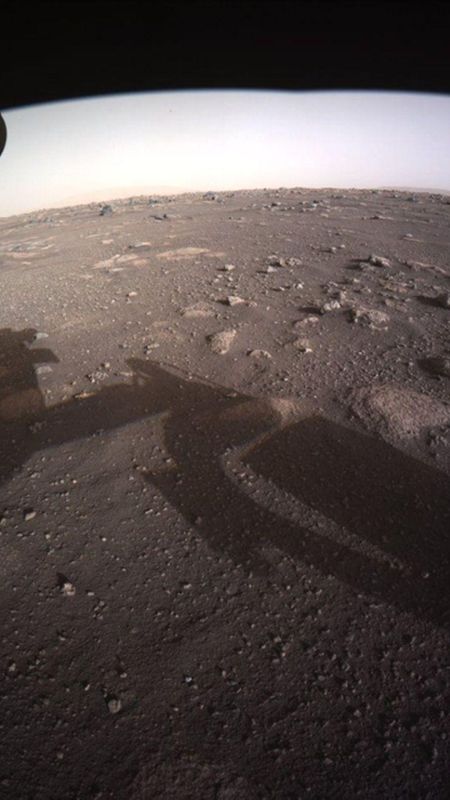NASA's newest rover touched down safely on the surface of Mars at 3:55 p.m. Eastern time on Thursday, completing a 293-million-mile journey through space and setting the stage for a mission that seeks to find evidence of ancient extraterrestrial life.
The six wheels of the 2,260-pound Perseverance rover landed in Jezero Crater, a former lake bed once fed by flowing water that scientists say would have been a welcoming home for microbes in Mars' warmer, wetter past. If they're right, the remains of those long-dead microbes should now reside in the sediments there.
Joyful team members in mission control at the Jet Propulsion Laboratory in La Cañada Flintridge could not hug or high-five one another, as they normally would in nonpandemic times. But even their doubled-up masks — whose top layer was adorned with a stylized image of the rover — didn't hide the smiles on their faces as they clapped and cheered, a few feet apart. Some bumped fists with those around them while others shook them triumphantly in the air.

Members of NASA's Perseverance rover team react in mission control after receiving confirmation the spacecraft successfully touched down on Mars. Credit: AFP PHOTO / NASA / Bill Ingalls
"NASA works," said Rob Manning, JPL's chief engineer and a veteran of many Mars missions. "When we put our arms together and our hands together and our brains together, we can succeed. This is what NASA does. This is what we can do as a country on all of the problems we have. We need to work together to do these kinds of things and make success happen."
Within moments of landing, the rover transmitted two black-and-white images from its hazard cameras showing the Martian terrain, with disturbed dust still floating from the rover's touchdown.


Perseverance, the star of NASA's Mars 2020 mission, survived a hair-raising arrival procedure that's often referred to as the "seven minutes of terror."
This final stage of the 6 1/2-month journey involved a dramatic deceleration from a speed of nearly 12,500 miles per hour at the top of the Martian atmosphere to a mere 1.7 miles per hour when it was just above the surface.
The carefully choreographed routine required a heat shield, a supersonic parachute, retrorockets and the "skycrane" maneuver, which involved lowering the rover from midair on a set of roughly 21-foot-long cables.

The Perseverance rover is lowered towards the surface of Mars during its powered descent. Credit: NASA via AP
Shortly before reaching the top of the atmosphere, the spacecraft used thrusters to bring its spin of two rotations per minute down to zero. "From here on out it's just going to be a bullet," Manning said.
Another pivotal moment in the landing sequence came when Perseverance successfully deployed its parachute. "Yes! Yes!" team members could be heard exclaiming upon confirmation that the rover had successfully slowed down.
Pulling this off in Jezero Crater was long considered unthinkable, since the site is strewn with sharp rocks and boulders, treacherous sand dunes and hazardous cliffs, officials said. But JPL engineers made this possible by equipping Perseverance with new technologies that gave the rover the autonomy to avoid such hazards without relying on instructions from handlers on Earth.
Arriving safely at Mars was just the first hurdle of the $2.4 billion Mars 2020 mission, which will last for at least one Martian year (that's about 687 days on Earth).
Perseverance has a lot on its to-do list. It's tasked with using its suite of sophisticated cameras and specialized instruments to search for so-called biosignatures — materials, textures and other telltale patterns in ancient rock that could be signs of past life. The rover's job will be to select a promising and diverse set of samples, which it will collect and stow on the surface for future spacecraft to retrieve and ferry back to scientists waiting on Earth.
Jezero Crater is an ideal spot for this work, geologists say. It features a delta — a clear sign that running water once flowed into a body of water like a lake. That would have been an ideal environment for trapping any microbial life that existed billions of years ago.
Perseverance will also deploy Ingenuity, a 4-pound, solar-powered helicopter that would be the first of its kind to fly on another world. If successful, it could pave the way for future flying planetary explorers.
And the rover will use an onboard instrument suite to synthesize oxygen using the carbon dioxide in the thin Martian atmosphere. The proof-of-concept experiment could show that it's possible on Mars to create both breathable oxygen and spacecraft fuel — two essential resources for any humans who may one day visit the red planet.
It will be several weeks before Perseverance embarks on its science mission. Until then, its handlers will be checking the rover, downloading new flight software for surface operations, and perhaps doing a few calisthenics — that is, stretching out to see if its robotic arm is moving as it should.
Women hoping to become deacons ... Out East: Southold Fish Market ... Get the latest news and more great videos at NewsdayTV

